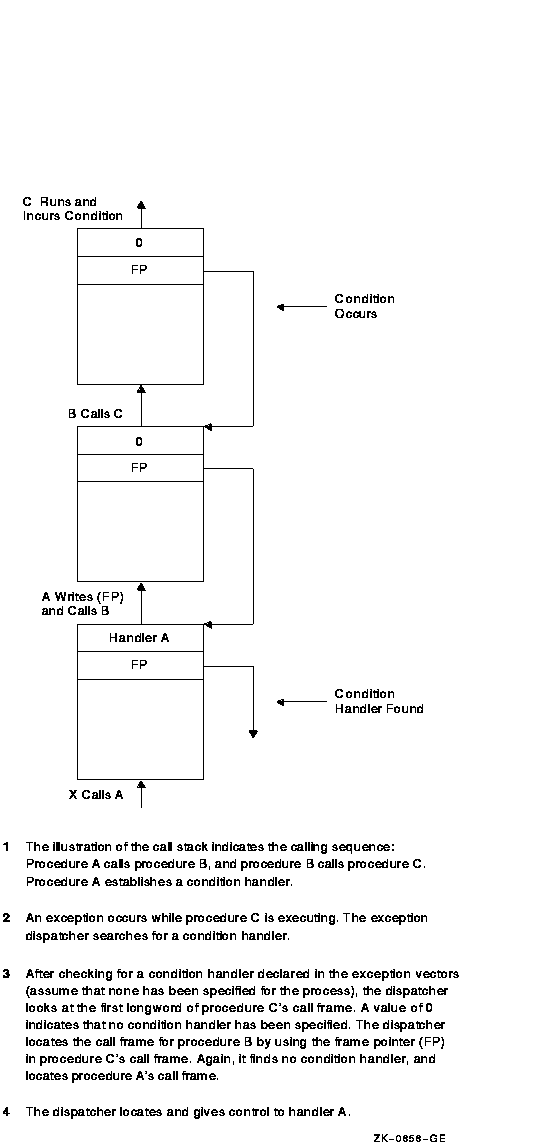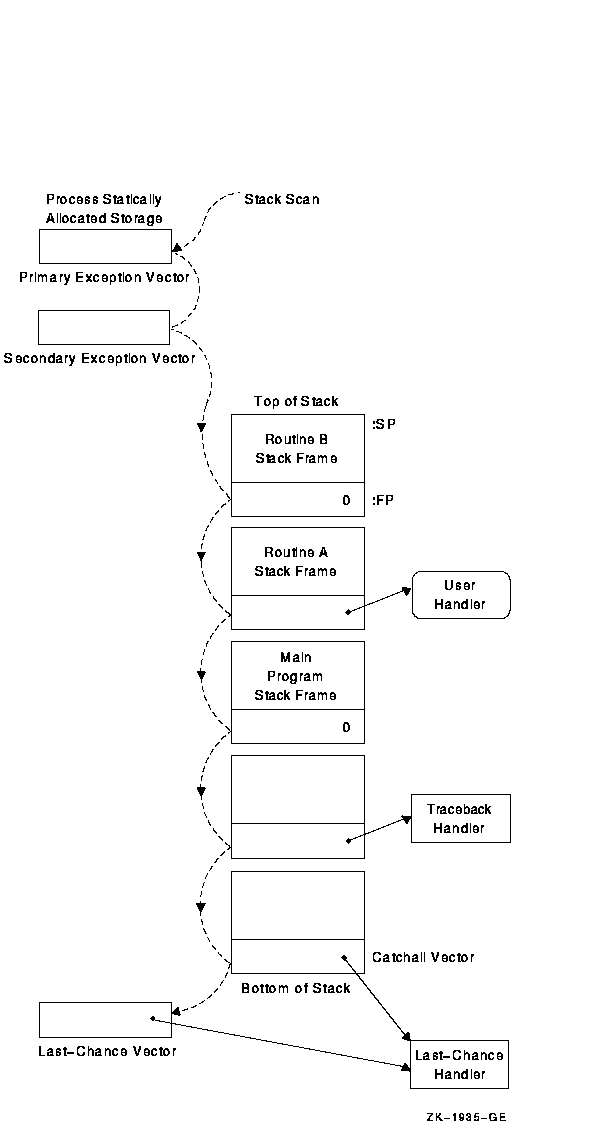HP OpenVMS Systems Documentation |
OpenVMS Programming Concepts Manual
9.5.1 Return Status Convention
Most system-defined procedures are functions of longwords, where the
function value is equated to a condition value. In this capacity, the
condition value is referred to as a return status. You
can write your own routines to follow this convention. See
Section 9.14.3 for information about how to change a signal to a return
status. Each routine description in the OpenVMS System Services Reference Manual, OpenVMS RTL Library (LIB$) Manual,
OpenVMS Record Management Utilities Reference Manual, and OpenVMS Utility Routines Manual lists the condition values that can be
returned by that procedure.
When a function returns a condition value to your program unit, you should always examine the returned condition value. To check for a failure condition (warning, error, or severe error), test the returned condition value for a logical value of false. The following program segment invokes the run-time library procedure LIB$DATE_TIME, checks the returned condition value (returned in the variable STATUS), and, if an error has occurred, signals the condition value by calling the run-time library procedure LIB$SIGNAL ( Section 9.8 describes signaling):
To check for a specific error, test the return status for a particular condition value. For example, LIB$DATE_TIME returns a success value (LIB$_STRTRU) when it truncates the string. If you want to take special action when truncation occurs, specify the condition as shown in the following example (the special action would follow the IF statement):
9.5.1.2 Testing SS$_NOPRIV and SS$_EXQUOTA Condition ValuesThe SS$_NOPRIV and SS$_EXQUOTA condition values returned by a number of system service procedures require special checking. Any system service that is listed as returning SS$_NOPRIV or SS$_EXQUOTA can instead return a more specific condition value that indicates the privilege or quota in question. Table 9-7 list the specific privilege errors, and Table 9-8 lists the quota errors.
Because either a general or a specific value can be returned, your program must test for both. The following four symbols provide a starting and ending point with which you can compare the returned condition value:
The following Compaq Fortran example tests for a privilege error by comparing STATUS (the returned condition value) with the specific condition value SS$_NOPRIV and the range provided by SS$_NOPRIVSTRT and SS$_NOPRIVEND. You would test for SS$_NOEXQUOTA in a similar fashion.
9.5.2 Modifying Condition ValuesTo modify a condition value, copy a series of bits from one longword to another longword. For example, the following statement copies the first three bits (bits <2:0>) of STS$K_INFO to the first three bits of the signaled condition code, which is in the second element of the signal array named SIGARGS. As shown in Table 9-6, STS$K_INFO contains the symbolic severity code for an informational message.
Once you modify the condition value, you can resignal the condition value and either let the default condition handler display the associated message or use the SYS$PUTMSG system service to display the message. If your condition handler displays the message, do not resignal the condition value, or the default condition handler will display the message a second time. In the following example, the condition handler verifies that the signaled condition value is LIB$_NOSUCHSYM. If it is, the handler changes its severity from error to informational and then resignals the modified condition value. As a result of the handler's actions, the program displays an informational message indicating that the specified symbol does not exist, and then continues executing.
9.6 Exception DispatcherWhen an exception occurs, control is passed to the operating system's exception-dispatching routine. The exception dispatcher searches for a condition-handling routine invoking the first handler it finds and passes the information to the handler about the condition code and the state of the program when the condition code was signaled. If the handler resignals, the operating system searches for another handler; otherwise, the search for a condition handler ends. The operating system searches for condition handlers in the following sequence:
The search is terminated when the dispatcher finds a condition handler. If the dispatcher cannot find a user-specified condition handler, it calls the condition handler whose address is stored in the last-chance exception vector. If the image was activated by the command language interpreter, the last-chance vector points to the catchall condition handler. The catchall handler issues a message and either continues program execution or causes the image to exit, depending on whether the condition was a warning or an error condition, respectively. You can call the catchall handler in two ways:
Figure 9-4 illustrates the exception dispatcher's search of the call stack for a condition handler. Figure 9-4 Searching the Stack for a Condition Handler 
In cases where the default condition handling is insufficient, you can establish your own handler by one of the mechanisms described in Section 9.2.1. Typically, you need condition handlers only if your program must perform one of the following operations:
9.7 Argument List Passed to a Condition HandlerOn VAX systems, the argument list passed to the condition handler is constructed on the stack and consists of the addresses of two argument arrays, signal and mechanism, as illustrated in Section 9.8.2 and Section 9.8.3. On Alpha systems, the arrays are set up on the stack, but any argument is passed in registers. On VAX systems, you can use the $CHFDEF macro instruction to define the symbolic names to refer to the arguments listed in Table 9-9.
On Alpha systems, you can use the $CHFDEF2 macro instruction to define the symbolic names to refer to the arguments listed in Table 9-10.
9.8 SignalingSignaling can be initiated when hardware or software detects an exception condition. In either case, the exception condition is said to be signaled by the routine in which it occurred. If hardware detects the error, it passes control to a condition dispatcher. If software detects the error, it calls one of the run-time library signal-generating routines: LIB$SIGNAL or LIB$STOP. The RTL signal-generating routines pass control to the same condition dispatcher. When LIB$STOP is called, the severity code is forced to severe, and control cannot return to the routine that signaled the condition. See Section 9.12.1 for a description of how a signal can be dismissed and how normal execution from the point of the exception condition can be continued. When a routine signals, it passes to the OpenVMS Condition Handling facility (CHF) the condition value associated with the exception condition, as well as optional arguments that can be passed to a condition handler. The CHF uses these arguments to build two data structures on the stack:
These two vectors become the arguments that the CHF passes to condition handlers. These argument vectors are described in detail in Section 9.8.2 and Section 9.8.3. After the signal and mechanism argument vectors are set up, the CHF searches for enabled condition handlers. A condition handler is a separate routine that has been associated with a routine in order to take a specific action when an exception condition occurs. The CHF searches for condition handlers to handle the exception condition, beginning with the primary exception vector of the access mode in which the exception condition occurred. If this vector contains the address of a handler, that handler is called. If the address is 0 or if the handler resignals, then the CHF repeats the process with the secondary exception vector. Enabling vectored handlers is discussed in detail in the OpenVMS Calling Standard. Because the exception vectors are allocated in static storage, they are not generally used by modular routines. If neither the primary nor secondary vectored handlers handle the exception condition by continuing program execution, then the CHF looks for stack frame condition handlers. It looks for the address of a condition handler in the first longword of the routine stack frame on VAX systems, or in the procedure descriptor (in which the handler valid bit is set) for the routine stack frame on Alpha systems where the exception condition occurred. At this point, several actions are possible, depending on the results of this search:
The OpenVMS Condition Handling facility searches for and calls condition handlers from each frame on the stack until the frame pointer is zero (indicating the end of the call sequence). At that point, the CHF calls the vectored catchall handler, which displays an error message and causes the program to exit. Note that, normally, the frame containing the stack catchall handler is at the end of the calling sequence or at the bottom of the stack. Section 9.9 explains the possible actions of default and user condition handlers in more detail. Figure 9-5 illustrates a stack scan for condition handlers in which the main program calls procedure A, which then calls procedure B. A stack scan is initiated either when a hardware exception condition occurs or when a call is made to LIB$SIGNAL or LIB$STOP. Figure 9-5 Sample Stack Scan for Condition Handlers 
9.8.1 Generating Signals with LIB$SIGNAL and LIB$STOPWhen software detects an exception condition, the software normally calls one of the run-time library signal-generating routines, LIB$SIGNAL or LIB$STOP, to initiate the signaling mechanism. This call indicates to the calling program that the exception condition has occurred. Your program can also call one of these routines explicitly to indicate an exception condition. You can signal a condition code by invoking the run-time library procedure LIB$SIGNAL and passing the condition code as the first argument. (The OpenVMS RTL Library (LIB$) Manual contains the complete specifications for LIB$SIGNAL.) The following statement signals the condition code contained in the variable STATUS:
When an error occurs in a subprogram, the subprogram can signal the appropriate condition code rather than return the condition code to the invoking program unit. In addition, some statements also signal condition codes; for example, an assignment statement that attempts to divide by zero signals the condition code SS$_INTDIV. When your program wants to issue a message and allow execution to continue after handling the condition, it calls the standard routine, LIB$SIGNAL. The calling sequence for LIB$SIGNAL is the following:
Only the condition-value argument must be specified; other arguments are optional. A description of the arguments is as follows:
When your program wants to issue a message and stop execution unconditionally, it calls LIB$STOP. The calling sequence for LIB$STOP is as follows:
|